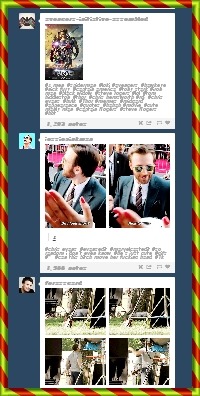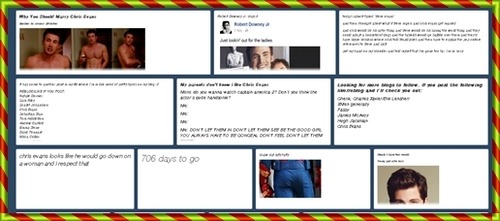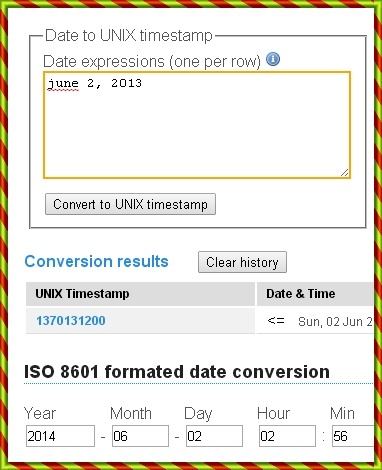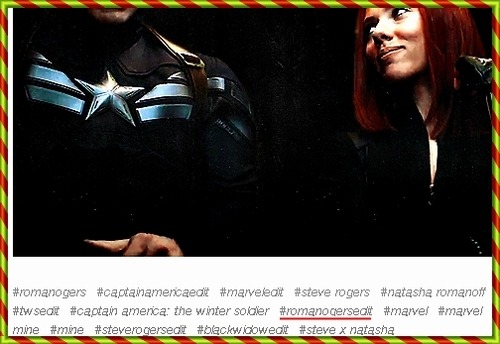How To Look Up Tags On Tumblr Blogs
ETA:
Tumblr's search has always been a bit buggy, and it has not always done *exactly* what it was supposed to do. But it seems like it was updated again in spring of 2017 and can no longer search multiple hashtags with multiple words. If you want to cross search multiple subjects, the best way is to find the most unique single word possible to represent each subect and search those without the hashtag.
Tumblr unveilved the new "Tumblr Search" 8 months ago, but understanding the fine points of how it works or how to benefit from it most isn't always straightforward. (Many of you probably know most of this, but hopefully there are at least one or two things that will be useful to everyone.)
Basics of searching
The Tumblr search bar can either be found at tumblr.com/search or in the upper right hand corner of your dashboard.

When you do a search for a subject - for example, Chris Evans (he will be my lovely assistant today) - tumblr will search the tags of all the posts on tumblr looking for mentions of Chris Evans. It will also search text in the body of the post (including titles, chat posts, and quotes), however this is less consistent, and less effective with older posts and longer phrases.
Tumblr will return search results in the following way: first it will show you the posts from the past 24 hours in order of popularity (number of notes), then it will list the most popular posts of all time. You can view your search results as a grid

or in "list view" (traditional dashboard viewing).

This is controlled by the buttons on the right hand side underneath the recommended blogs related to the search subject.

On the left side you can filter the posts by type - for example, you can look only at text post results:


Or you can view your search results in order of what is most recent instead of what is most popular.
Searching mentions vs. searching tags
Tumblr's search function is smart, and so a search for Chris Evans will also turn up posts tagged/captioned with only "Chris fucking Evans, ladies and gentlemen", which can be very helpful.
BUT if, for example, you're searching "A Dance Of Clowns", a lovely piece of music by Mendelssohn, and your top result is some creepy ass clown like out of a disturbed child's nightmare because that post was tagged with "Pennywise the dancing clown", then you probably want to search for that specific tag.
This is done two ways.
1) You can add a hashtag (#) to the beginning of your subject when you type it into the search bar:

When there is a hashtag, tumblr will search only the tags for the exact wording of your search term.
2) Or you can manually change "search" to "tagged" in the address bar. (Do not search using the hashtag if you are going to do this.)
A tumblr search will appear in your address bar as tumblr.com/search/subject:

This in the address bar will show only tagged posts:

(plus signs and dashes are interchangeable)
Method #1 is more useful because it allows you to filter posts by post type. And because it allows you to search multiple subjects. (But the /tagged/ method has a few advantages as well which I'll explain later.)
Searching multiple subjects
You can easily search for multiple subjects by entering them one after the other in the search bar with a hashtag before each subject. So if, for example, you wanted to find posts that in which Steve Rogers and Natasha Romanoff were both featured you could do a search like this:

And the results would turn up the way they always do for a search - the most popular over the past 24 hours first, and then the most popular for all time. And you can filter them by post type or view them by most recent, etc.
But why stop at two? If you were interested in Steve and Natasha in The Avengers, then you could search #steve rogers #natasha romanoff #the avengers. Or #chris evans #scarlett johansson #the avengers #behind the scenes. Or #the avengers #doctor who #au. Or #the avengers #steve rogers #reactions. Etc.
How to take advantage of Tumblr Search
If you're looking exclusively for edits, you can filter by post type (photo posts only) or you can do a multiple subject search using the fandom edit tag - like #steve rogers #marveledit. The latter will turn up less results but overall better quality ones. You can also search #mine or #my gifs or #my edits, etc., in combination with a character or ship tag because many people use those tags to designate their original edit posts.
You can easily browse the most popular posts for very active fandoms by doing a quick search for the fandom name each day. (Or ships, or celebrities, or characters, etc..) I particularly like to be sure to do a search about 12-20 hours after a new episode has aired in order to see what the most popular posts about that episode were. (Though remember the most popular posts are often just the ones that came first, and sometimes, particularly with edits, ones that come later are generally better and it might be worth scrolling further.)
Blacklisting your notps, anti tags, and things like iheartit and getglue will also make browsing through tags a more pleasant experience. (I highly recommend xkit. You won't believe how much easier it'll make your life.)
One of the advantages of browsing a tag in the /tagged/ format is that you can choose to enter the tag at a specific date. This can be useful if you haven't seen the most recent episode of a show and would like to go back to one of that fandom's tags before the episode had aired, if you're just curious about what was going on in the tag a long time ago, or if you plan on going through the entire tag but not all at once, and want to mark your place so you can return to it later. The list of posts in the tag can be broken up using a UNIX time stamp which is based on the absolute date of the post's publishing on not on its relativity to the present.
In order to visit a specific date in the tag (and you can then scroll backwards in time from there), you can visit this site and enter the date in to the time stamp generator. Then you go to the tag on tumblr and add "?before=" and then add the time stamp onto the end. So for example, if I wanted to see what people were posting in the Chris Evans tag one year ago, I would enter that date into the generator

My time stamp is 1370131200. So to visit the Chris Evans tag at that date, I want this in my address bar:

Success! (It looks like they were posting good stuff.)
In order to find your place in a tag you are scrolling through all you need to do is reblog the last post you are looking at. You can draft or queue that reblog, or you can cancel it. When the page refreshes it will give you the timecode for your place in the tag. You can then bookmark your place or make a note of the date and find it again using the method above.
TUMBLR SEARCH DOES NOT DO THIS. If you reblog a post when using the search function in a new tab, when the page refreshes it will take you back to the very beginning. For this reason - unless you're searching regularly by "Most Recent" - you basically have just one shot to look at everything, unless you want to scroll through it all again just to reach the posts you didn't get to before.
Some tips for tagging effectively are under the cut
Tagging effectively to get more notes
When you tag a new original post, keep in mind that when someone goes through the tracked tags (tumblr.com/tagged/____) your post will only come up if the tag they are searching is one of your FIRST FIVE TAGS on that post. So always put the most important tags first and leave your commentary and personal tags for your blog for last.
Tags after the first five will still come up in mention searches and hashtag searches. For example, I don't use "romanogersedit" as one of my first five tags for my Steve/Natasha edits because no one is going to be tracking that tag,but I still tag with it because if someone searches for romanogersedit then all of my Steve/Natasha edits will still show up in that search. (Well, some of them. It's a little inconsistent.)



So tags after your first five are still important.
Again, many of you already know all of this so I hope it doesn't sound like I'm talking down to you at all and certainly I don't have any authority just the experience of years squandered on this site.
The most important tip is to use your first five tags wisely. Think about what tags people will be tracking or checking.
–No one is going to check the tag 2x13, so using up one of your first five tags on the number of the episode is not the best use of that slot.
–If the character has a common first name but no known last name then don't bother using their name as one of the first five tags, and be sure to tag the actor.
–This bears repeating: if you use certain tags for characters, ships, fandoms, etc., on your blog that are not the regular tags for tumblr as a whole, save those for right before your commentary tags. This includes series that you're doing (like 50 HD close-up pics of Chris Evans' pecs – 100cepecs – for example – btw can someone please do that?). Unless you want your series to work as a tracked tag, which is cool too.
DO YOUR RESEARCH. If you don't know what the ship name is, or the edit tag is, or whether to call her Queen Ravenna or just Ravenna, then just spend a few minutes trying to figure it out. Try out the tag, scroll down a little, see how often posts are being made in that tag, check out what those posts are tagged with, and then compare. 90% of the time it'll be pretty clear which tag is more popular. USE THE MORE POPULAR TAG. Even if you prefer the other ship name or you think it should just be Flint and not Captain Flint, please please please just use the more popular tag because that's better for everyone. If your post is worth making, then isn't it worth figuring out where it should go and where people will be looking for it?
Use edit tags. If you've made a graphic, or a gifset, or a picspam, or edited a screencap, then put it in an edit tag so that people who are only looking for edits can find it more easily. Most fandoms have them, and very active fandoms also have them for ships and characters. Typically it's the title of the movie or show, no spaces and no articles, +edit. Avengersedit. Captainamericaedit. If there's a very common abbreviation, than that is typically used. aosedit. gotedit. The same with characters. Sansastarkedit. Steverogersedit. But sometimes it's different. Spncastiel, for example. Which is why it's always good to do your research. Popular celebrities also have edit tags. Putting your post in an edit tag will keep it relevant for longer because edit tags aren't as active and are less tedious to go through, which means visitors will scroll for a long time and see older stuff.
Contrary to popular belief, you *can* change your tags after publishing your post, and they will still be searchable. So if you notice a typo, fix it. If you realize the tag you used isn't the best one to have used, change it. Just keep in mind that you'll have to retype all of the other tags that followed it, if you want that tag to be one your first five.
Bonus tips:
-Make new posts when tumblr is most active (so not when it's the middle of the night in the United States. Friday evenings in the US and Saturdays tend to be slower as well).
-Check the tags right before you post or better yet before you start editing. If something very similar to what you made is going around or has been recently posted by someone else then you would be better off waiting and posting it in a few weeks or more. People won't reblog if they've just seen/reblogged the same thing.
-No matter how well you tag there's no equivalent for having a lot of followers. But being reblogged by someone (or a subject-specific blog) with a lot of followers is almost as good. Find out what tags they track and when they check them, or if they follow you, post or reblog your post when they're on their dashboard. Don't be pushy about it, of course, but there's nothing wrong with arranging for someone who will like your post to see it.
Tips for tagging effectively to not be a buttface (aka tips for tagging effectively to be a tumblr user who is considerate of others)
Again, this is just what I've observed as a longtime tumblr user.
Please don't tag your hate. People who check the tags are people who like the thing. They don't want to see your hate – even if it's thoughtful, valid, well-argued criticism – and you're not going to change their minds. They'll just ignore you (one hopes), or it'll get ugly. If you need to tag the thing for the sake of you own blog, then definitely make sure it's not one of your first five tags. (Though coming up with a unique tag for your blog is best.) This is particularly important with real people, characters, and ships. Tagging the fandom in negative posts is generally regarded as totally fine.
Do not tag the ship if your post is just you stating that you don't ship it romantically or explaining why you don't ship it romantically. While you might not consider this "hate", people checking the tag do not want to see it. You can discuss the relationship platonically in the character tags or you can develop a new tag for the platonic relationship. But edits are fine.
If you're going to make a negative post, use an anti tag. Again, do your research to find out what the anti tag is the for the thing you dislike so much. If one doesn't exist yet, then congrats, you get to be the first post. Anti tags allow you to connect with others who feel the same way and it allows your followers and people browsing through the tags to blacklist/tumblr savior your post so they don't have to see it. Some people don't think anti tags are a good idea so it's controversial but in my opinion I do think it's better. (In fact I love going through anti tags I will confess that freely.)
Don't tag your post with stuff that's not in your post. If you're making a general statement and than tagging with things it applies to, that's ok. But if you edited a screencap of Steve Rogers all by himself and then tagged it with every single character in The Avengers, all of their actors, and then opened up a dictionary and tagged it with every word you could find, then you're wrong and don't do that. I know you want to get notes but come on, have some honor. Tagging a picture of an actor with every role they've played and every movie they've ever been in is more controversial. It'll get you notes, but in my opinion it shouldn't be done on principal. (If I'm searching a character then I'm looking for pictures of that character, not the actor. If I wanted pictures of the actor, I would have searched for the actor. But that's just my take.)
DON'T PUT SOMETHING THAT'S NOT AN EDIT IN AN EDIT TAG. That's the worst offense there is. The whole point of the edit tag is to avoid stuff like that.
And finally: think long and hard about what you're about to post and what you're about to tag it with, and ask yourself seriously if anyone checking those tags is going to want to see your post. That sounds harsh, but let's be real. Your followers care, but people going through the tags probably don't. What is your post bringing to the tag? Is it just something you're making them scroll past? Are you wasting their time? So think about your first five tags and whether your post is worth tagging. Obviously you need to tag it for your own blog's purposes, so you can come up with a unique tag for your blog, or you can skip the first five tags by using them up on tags people won't check, like jibberish or commentary, etc.
For example: "I'm going to see The Winter Soldier tonight. So excited!" People going through the tags for the Winter Soldier don't need to see that post. Especially when it's one of 30 posts just like it. So don't tag it in a way that'll force people going through the tags to see it. "Eating a grilled cheese and watching Captain America. Best lunch ever." All that post has done is make me crave a grilled cheese. It's certainly not an interesting post about Captain America.
So, please don't become insecure about whether what you've said is smart enough or funny enough (or whether it has been said before because there's no reasonable way of knowing), just be mindful when tagging of the fact that everyone going through the tags will be seeing your post.
Also be mindful of what is potentially triggering and tag it. There's no good reason not to be courteous of others.
tags for your blog
Thanks to generous geniuses, there are two very easy methods of changing the tags on your blog. Using this app or the aforementioned xkit, you can type in a tag you would like to change, and then type in what you want to change it to, and these wonderful technologies will make those changes for you. You can also append a new tag (so you can add the tag "mcu" to every post tagged with "captain america", for example) or you can erase the tag from every post that is tagged with it.
This is very useful for a million reasons, but especially if you want to create a new unique tag for your blog for a certain subject (like if I wanted to start tagging Chris Evans on my blog as "precious meatball" I could make sure that all of the posts of him I already had on my blog were tagged that way as well).
Just be careful because there's no going back if you accidentally do the wrong thing, and be particularly careful of punctuation tags.
ETA:
Tumblr's search has always been a bit buggy, and it has not always done *exactly* what it was supposed to do. But it seems like it was updated again in spring of 2017 and can no longer search multiple hashtags with multiple words. If you want to cross search multiple subjects, the best way is to find the most unique single word possible to represent each subect and search those without the hashtag.
How To Look Up Tags On Tumblr Blogs
Source: https://fandomfatale.tumblr.com/post/90381516678/how-to-take-advantage-of-tumblrs-tagging-system-search
Posted by: conleywaseve1964.blogspot.com

0 Response to "How To Look Up Tags On Tumblr Blogs"
Post a Comment